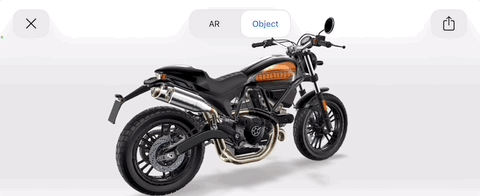Rise of the Machines:
How AI and 3D Visualization Are Crafting Hyper-Personalized Shopping Experiences
This is the year the experience of shopping hits a tipping point that will define survival for retailers, driven by the confluence of Artificial Intelligence (AI) and 3D visualization. Let’s dive into what leading retailers are doing to stay ahead of the wave.
Your shopping experiences are about to change.
Imagine you’re looking for a new mountain bike. You pick up your phone to start your search, and mountain bikes that fit your needs just start to appear, like magic. You learn all about them at your own pace, watching videos in social feeds. You start by learning about the bikes and turning them on your phone so you can see all the angles and details. You see just the information you’re looking for at the right time, as if the bike itself was giving you a personal consultation. Each bike you see looks more and more like what you’re looking for. 
You narrow down to a favorite, and add a personal touch with the color of the handlebars. You see the bike change before your eyes and you’re certain it’s what you need. You hold your phone up and see exactly what it will look like at full-size next to your other bike in your home. You decide to get your final setup at a dealer nearby, and when you arrive they have your exact specs and preferences at the ready.
All of those seamless experiences are working like magic via the fusion of 3D visualization and AI personalization.
Here are 3 key ways the future of shopping is transforming shopper experience:
Solving the paradox of choice
Retailers with a wide selection of choices or configurations reach a tipping point where too many choices frustrate shoppers and leave them feeling indecisive. Innovative brands are already using AI personalization as a solution. You risk losing customer loyalty if you deliver a generic experience, with 62% of consumers saying they won’t remain loyal after an un-personalized encounter.
For example, Amazon uses AI to track your browsing and purchase history to make recommendations for products you might be interested in. Netflix uses AI to create personalized homepages for each user, with movie and TV show recommendations based on their past viewing history.

Retailers that leverage configurable 3D products with AI to recommend and visualize the exact right product for a customer’s unique needs in real-time, are reaping the benefits of powerful experience, buyer confidence, and greater conversion.
This leads to a more individualized marketing experience where the buyer can see product visualizations that are created just for them, with 3D powering endless angles and configurations, and AI personalization finding just the right visuals, motion, and information. And, it doesn't just stop there - Adweek reports that personalization can lower acquisition costs by as much as 50%!
Next-level storytelling
Storytelling and 3D. Leading retail brands are first and foremost great storytellers, and they are always adding the latest technology to further that story. 3D and immersive visualization is a medium proven to tell more powerful stories than ever before. With 3D and AI, retailers will be able to craft stories that center their product within the buyer’s individual story, and even evolve it with the buyer. This means product imagery and waypoints can be tailored to the stage of the buyer’s journey. Buyers can get the right level of information at each step with progressive discovery. They can see what the product looks like in videos and images that look like their own environment, because the 3D product itself instantly adapts to both explicit and implicit signals from the user.
Turning the analytics black box into an R&D machine
How much do you really know about what aspects of the product interest the buyer? Combining 3D interaction analytics with AI pattern recognition is a promising next step for product-driven retailers. By using platforms that center the product creation process in 3D, retailers like Trek are evolving their products faster, and with more confidence in meeting the needs and desires of buyers.
This is the future of shopping with AI and 3D – infinitely flexible, yet ever-more personal.
As digital natives come of age, these technologies are key to meeting their expectations for tailored, fully-immersive experiences. As a mobile-first shopper, I can’t wait to leave behind the tedious searching and wading through irrelevant choices of the past. E-commerce leaders, I want to hear from you. What new experiences are you hoping to see?